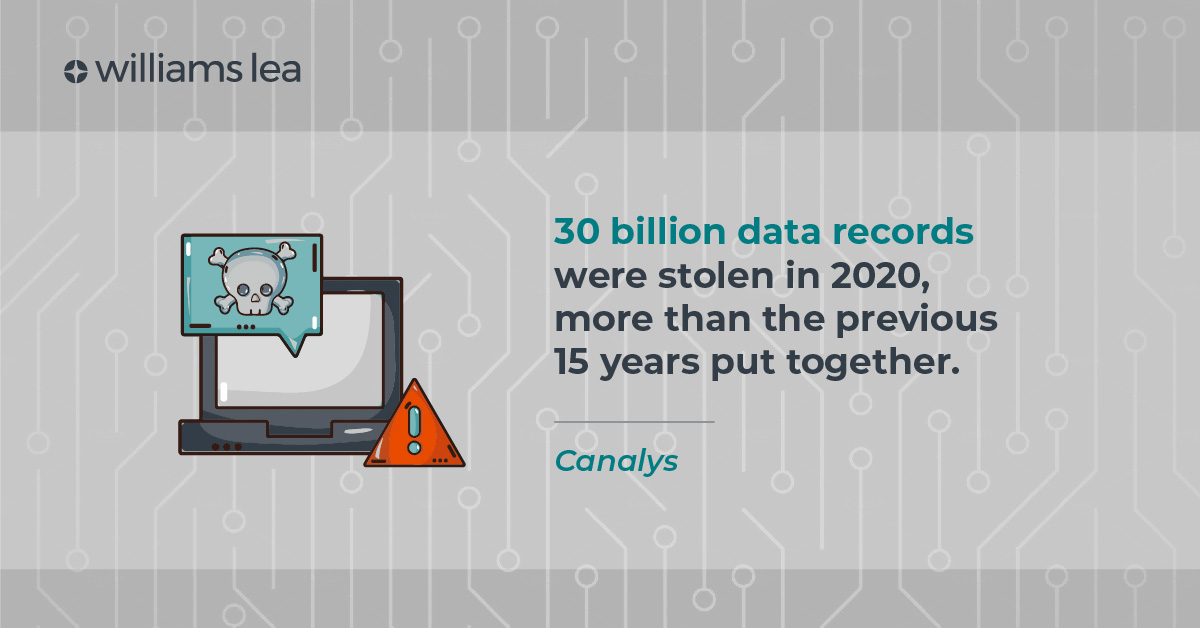September 09, 2021
Even before the COVID-19 pandemic, cybercrime was growing exponentially. Now, with the shift to remote and hybrid working, the global cost of cybercrime has risen by 50% since 2018 to more than US$1 billion last year[1]. 30 billion data records were also stolen in 2020, more than the previous 15 years put together[2].
With the rise of remote working, connected networks and cloud-based technology, businesses of all sizes face an ever-increasing threat of cyber-attacks. With 2020 breaking records for data breaches, information security has become more important than ever. By the end of this year, worldwide business investment in cybersecurity is set to reach US$150 billion[3].
Although technology investment to combat cybercrime is vital for all businesses, it won’t amount to much if the people connected to your company–whether they are employees, contractors, or outsourcing providers don’t have the right training–especially as 95% of cybersecurity breaches are caused by human error[4].
Your employees need to be fully prepared
Training your employees with the right skills to recognize and respond to cyber attacks should be conducted with the same frequency as your technology updates. Most businesses update their networks monthly, if not daily, to prevent data breaches. These updates should be paired with employee communications on the latest malware and tactics cybercriminals are using to breach networks.
Examples of best practices for employee awareness include e-newsletters, the company intranet page, mandated online training, staff webinars hosted by risk and compliance, and promoting e-learning. The better educated teams are on the potential dangers and the latest tricks hackers use to dupe unsuspecting employees, the more you will protect your company and clients from the risk of a significant breach.
Choose partners that take information security seriously, and can provide proof
Before the pandemic many organizations, from banks to law firms, were apprehensive about moving any software “off premises” or to the cloud because of concerns about protecting their sensitive data. They demanded all work, whether done by their employees or vendor partners be done behind their firewall. The pandemic forced them to shift to new workforce dynamics, allowing those dealing with sensitive information to work remotely forcing their tech teams to scramble to upgrade their security protocols and systems simultaneously. Those workers included outsourced support staff helping create pitchbooks or legal documents, performing administrative tasks and providing billing and accounts payable support. Outsourcing providers that had proven security protocols and proactively mandated training across all critical areas for their teams had the ability to pivot to secure remote working for their financial, professional and legal clients.
In this digital age with cybercrime rising rapidly, businesses that outsource services should ensure they work with external business partners who hold ISO27001 certification, regularly evaluate the welfare of employees, and maintain operational service delivery with a strong global security framework.
Combine strong security with innovative workflow solutions
Additionally, outsourcing partners need strong security protocols embedded in their unique enterprise-wide digital workflow tools. In addition to facilitating fast, accurate and efficient service delivery, it’s important that workflow tools are secure and protects client data. They need to provide complete chain of custody and audit trails for sensitive data and information. So that the “human” touchpoints are trackable too.
In our previous Future of Work blog on three ways to manage a new hybrid workforce, one of the key points made was the right tools can’t work properly without the right people. That’s why business leaders need to have their own skilled people with the right cybersecurity training, and they need to ensure that the external partners they work with are in lock-step when it comes to preventing cybercrime.
To find out more on workplace of the future, download our latest report on Hybrid working: A future of work brief.
[1] Source: Atlas VPN: https://bit.ly/3iWUlup, February 2021
[2] Source: Canalys: https://on.ft.com/37VQ04q, July 2021
[3] Source: Gartner: https://bit.ly/37ZZDyQ, January 2021
[4] Source: Cybint: https://bit.ly/3k7tTgL , March 2021
Share
How we help
-
Access global support capabilities
Providing 24/7, follow-the-sun support that delivers consistent, uninterrupted service
-
Accelerate digital transformation
Building a digital-first support model through innovative tech-led processes
Insights
Case
Studies
It is a long established fact that a reader













